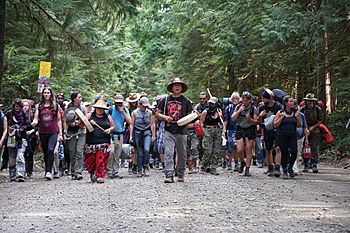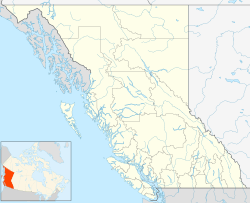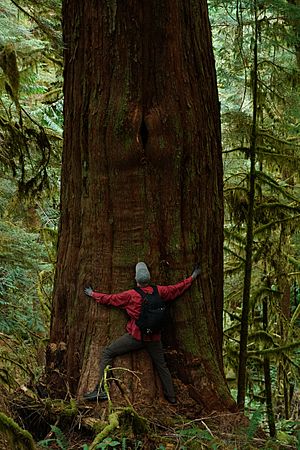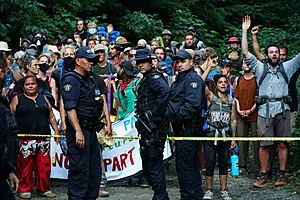Fairy Creek old-growth logging protests facts for kids

Protesters retake camp Land Back from the RCMP at the Fairy Creek blockade
|
|
| Geography | |
|---|---|
| Location | Vancouver Island |
| Coordinates | 48°35′1″N 124°21′0″W / 48.58361°N 124.35000°W |
| Administration | |
| Province | British Columbia |
| Regional district | Capital Regional District |
| Pacheedaht First Nation | |
In 2020 and 2021, many people in British Columbia, Canada, began protesting against the cutting down of very old trees. These protests mostly happened around a place called the Fairy Creek watershed on Vancouver Island. A watershed is an area of land where all the water drains into a single river or lake.
These events are a big part of British Columbia's history. They show how people often disagree about protecting nature and using forests for industry. The Fairy Creek protests remind many of similar events in the 1990s, like the "War in the Woods" and the Clayoquot protests. More than 1,000 people were arrested at Fairy Creek by February 2022. This makes it one of the largest acts of peaceful protest in Canadian history.
Contents
Why People Are Protecting Old Forests
Protests against cutting down old-growth trees grew stronger in late 2020. These trees are very old and large, sometimes hundreds or even thousands of years old. They are important for nature and wildlife. The protests focused on sensitive forest areas in southern Vancouver Island.
A big report about protecting old-growth forests in British Columbia came out in Fall 2020. People were upset when the government was slow to follow its suggestions. Also, more logging started in important old-growth areas, like the Fairy Creek watershed. A company called Teal Jones was doing some of this logging. However, most of the Fairy Creek watershed is already protected. It is a special area for old trees and wildlife.
Indigenous Voices and Land Rights
The Fairy Creek watershed is part of the traditional lands of the Pacheedaht First Nation. The elected leaders of the Pacheedaht First Nation said in 2021 that they did not support the logging protests. They said they have the right to manage the natural resources on their land. The Pacheedaht First Nation has an agreement with the government of British Columbia about sharing money from forestry.
This agreement helps the First Nation build their economy. They can buy businesses and land. In return, they agree not to stop logging activities approved by the province. They also agree to help solve problems if their members act against the agreement.
However, Pacheedaht Elder Bill Jones, whose family has long been decision-makers for the territory, supported the protests. He spoke about taking good care of the Fairy Creek watershed. He was against destroying sacred places for quick money. Leaders from the Tsleil-Waututh First Nation also visited Fairy Creek to show their support.
On June 4, 2021, the Huu-ay-aht First Nations, Ditidaht First Nation, and Pacheedaht First Nation signed a special paper called the Hišuk ma c̕awak Declaration. This declaration said they were taking back control over their traditional territories. The next day, they asked the B.C. government to stop old-growth logging for two years in Fairy Creek and other areas. This would give them time to plan how to manage their lands.
Doug White, a lawyer and former chief of the Snuneymuxw First Nation, explained this declaration. He said that Indigenous peoples have rights to their land. He mentioned that current logging rules might not fit with these rights. He also referred to the United Nations Declaration on the Rights of Indigenous Peoples (UNDRIP). This declaration says that Indigenous peoples have the right to make decisions about their lands and resources.
Wildlife and Nature in Fairy Creek
The Fairy Creek area is home to many important plants and animals. On May 31, 2021, officials confirmed that endangered western screech owls live there. These owls are a type of small owl.
In July 2021, surveys also found over 240 sightings of endangered marbled murrelets. These are small seabirds that nest in old-growth forests.
Rare lichens, like the old-growth specklebelly (Pseudocyphellaria rainierensis), have also been found in Fairy Creek. Lichens are like moss, growing on trees and rocks. This special lichen grows because of the nutrients from old yellow cedar trees in the watershed.
Protests and Blockades
Even with the COVID-19 pandemic, people kept protesting through Spring 2021. They used social media to ask for more help when police removed activists from their camps. The protesters were very creative in how they stopped logging. They built "sleeping dragons" out of pipes and concrete to chain themselves to equipment or roads. They also used "flying dragons" to hang themselves high up in trees. This made it very hard for police to remove them.
On May 22, 2021, Tzeporah Berman, a well-known environmental activist, visited Fairy Creek. She was arrested for going into an area that police had blocked off. Days later, many senior citizens joined the protesters. They were invited by Pacheedaht Elder Bill Jones. They walked past the police blockade without any problems. Protests also happened in other places, like in Greater Victoria. Some were held outside the office of British Columbia Premier John Horgan. His political area includes some of the disputed old-growth forests.
By late August 2021, the Fairy Creek protests were close to setting a Canadian record for peaceful protest. In 1993, 856 people were arrested during the "war in the woods" in Clayoquot Sound. Fairy Creek had over 1,000 arrests, making it one of the biggest acts of peaceful protest in Canadian history.
On September 29, a court in British Columbia said no to the logging company's request. The company wanted to extend the order that stopped protesters from blocking roads.
Media Coverage of the Protests
On May 19, a journalist trying to report on the protests was arrested by the RCMP. The police said the journalist was getting in the way of the logging company's work. However, videos online showed the journalist asking police what they were blocking before being arrested.
In May, a group called the Rainforest Flying Squad said that Instagram deleted their account. This happened after they posted a video showing police arresting protesters. The account was put back the next day. A Facebook spokesperson said it was deleted by mistake.
On May 26, several news groups announced they would sue the RCMP. They said the police were stopping media from reporting on the protests. On July 20, 2021, these news groups won their case in the British Columbia Supreme Court. The court added a rule to the order given to the logging company. This rule said the RCMP should not stop media from doing their job unless there was a very good reason.
Arrests and Police Actions
On May 28, 2021, the RCMP arrested almost all the protesters at the Waterfall Blockade. They said they could not safely arrest one person. The next day, hundreds of protesters returned and set up the blockade again. On August 9, 2021, which was one year after the blockade started, the RCMP raided the main Fairy Creek camp. Officers told protesters they had 24 hours to leave. But witnesses said the police started arresting people before the time was up. More than 20 protesters were arrested. A nearby camp was also closed. By February 11, 2022, over 1,000 protesters had been arrested.
Many people complained about the RCMP's actions. By August 2021, individual journalists and protesters had made over a dozen complaints. These complaints included using too much force and taking away food, water, and personal items. Some police officers were also seen wearing "thin blue line" patches. This symbol is not allowed by official RCMP rules.
Public Awareness and Support
Social media and online fundraising helped spread the word about the Fairy Creek protests. This was important during the COVID-19 pandemic. At that time, people in British Columbia could only travel for important reasons.
In Spring 2021, actor and photographer Cole Sprouse visited Fairy Creek. He supported the protesters and shared photos of the old-growth forest and the protests. Other famous people also supported the protesters. These included actor Mark Ruffalo and former wrestler Hulk Hogan. Musicians Bruce Cockburn and Midnight Oil allowed protesters to use their songs on social media. In June 2021, Vogue magazine also featured photos of the land defenders at Fairy Creek.
On May 24, 2021, a writer named Gary Geddes crossed the police line at Waterfall Camp. He was arrested to help bring more attention to the protests.
On July 1, 2021, PBS Digital Studios released a video called Terra. This video explained special things about the temperate rainforest in Fairy Creek. It talked about how trees connect underground and how soil forms in the tree canopies. These things are still not fully understood. The video encouraged people to protect the forest. It was part of the Overview series on the PBS website and YouTube.




